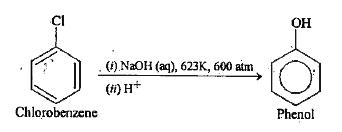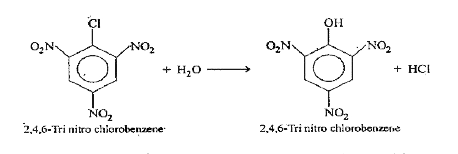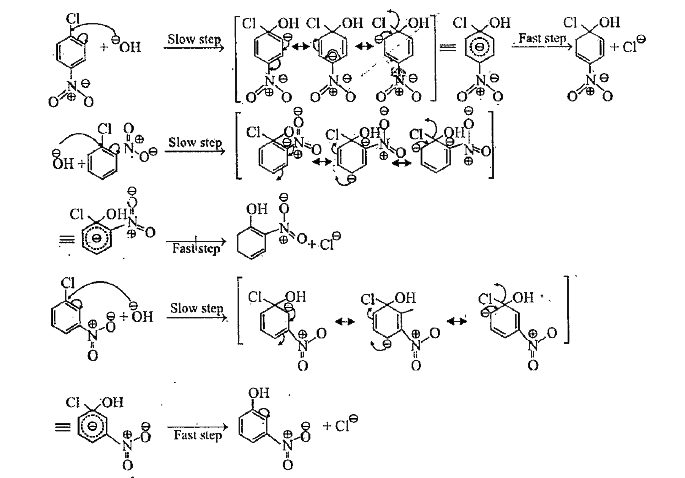The presence of electron withdrawing group increases the reactivity of haloarenes towards nuncleophilic substitution reaction. Explain.Solution in Punjabi
Chlorobenzene can be converted into phenol by heating in aqueous NaOH at 623K and under a pressure of 300 atmosphere.

However in the presence of electron withdrawing group (−NO2) at-o and p-positions the same hydrolysis can be carried out by warming with water only

This is because the electron withdrawing groups at o and p-positions stabilises the intermediate carbanion by resonance. However, no effect on reactivity of haloarenes is obeserved if the electron withdrawing group in present at m-position because in that case resonance stablisation of carbanion in not possible. This is clear from the mechanism of the reaction explained below.

As shown, the presence of −NO2 group at o and p-positions withdraws the electrons density from the benzene ring and thus lielps in the attack of nucleophile on haloarenes. The carbonian so formed is resonance stabilised. The -ve charge appeared at o and.p-positions w.rt. halogen is stabilised by −NO2 group. While in case of m-nitrochlorobenzene none of the resonating structure, bears the -ve charge an carbon atom bearing the −NO2 group. Therefore, the presence of −NO2 group at m-position does not disperse the-ve charge and no effect an reactivity is observed by the presence of −NO2 group at m-position
Topper's Solved these Questions
- BOOK - BETTER CHOICE PUBLICATIONCHAPTER - GENERAL PRINCIPLES AND PROCESS OF ISOLATION OF ELEMENTS EXERCISE - Question Bank (6.6 OXIDATION-REDUCTION)15videos
GENERAL PRINCIPLES AND PROCESS OF ISOLATION OF ELEMENTS
- BOOK - BETTER CHOICE PUBLICATIONCHAPTER - ORGANIC COMPOUND WITH FUNCTIONAL GROUP CONTANING OXYGEN-IIEXERCISE - Question Bank (12.9 Uses of Carboxylic Acids)4videos
ORGANIC COMPOUND WITH FUNCTIONAL GROUP CONTANING OXYGEN-II
Similar Questions
Name the process from which chlorine is obtained as a bye-product. What will happen if an aqueous solution of NaCl'is:subjected to electrolysis?
02:26View SolutionSodium benzoate is used as a food additive. Why ?
04:57View SolutionAssertion (A) Presence of a nitro group at ortho or para position increases the reactivity of haloarenas towards nucleophilic substitution. Reason (R ) Nitro group, being an electron withdrawing group decreases the electron density over the benzene ring.
02:10View SolutionIn nuncleophilic substitution reactions the reactivity of carbonyl compounds follows order
02:35View SolutionAssertion: Presence of a nitro group at ortho or para position increases the reactivity of haloarenes towards nucleophilic substitution.
Reason: Nitro group, being an electron withdrawing group decreases the electron density over the benzene ring.02:10View Solutionहैलोजन परमाणु के सापेक्ष o- तथा p- स्थितियों पर ................... समूहों की संख्या बढ़ने पर, हैलोऐरीनस की नाभिकस्नेही प्रतिस्थापन अभिक्रियाओं के प्रति क्रियाशीलता बढ़ती है ।
04:38View SolutionAssertion: Presence of a nitro group at ortho or para position increases the reactivity of haloarenes towards nucleophilic substitution. Reason: Nitro group, being an electron withdrawing group, decreases the electron density over the benzene ring.
02:54View SolutionGive reasons:
(a) n-Butyl bromide has higher boiling point than t-butyl bromide.
(b) Racemic mixture is optically inactive.
(c) The presence of nitro group (−NO2) at op positions increases the reactivity of haloarenes towards nucleophilic substitution reactions.11:03View SolutionAssertion (A) : Presence of a nitro group at ortho-or para- position increases reactivity of haloarenes towards nucleophilic substitution.
Reason (R) : Nitro group, being an electron withdrawing group decreases the electron density over the bvenzene ring.View SolutionHaloarenes are _________ reactive than haloalkanes towards nucleophilic substitution reactions.
View SolutionWhy are haloalkanes more reactive towards nucleophilic substitution reaction than haloarenes?
03:44View SolutionGive reason :
The presence of nitro group (−NO2) at o/p positions increases the reactivity of haloarenes towards nucleophilic substitution reactions.01:39View SolutionAssertion (A) : Presence of a nitro group at ortho or para position increases the reactivity of haloarenes towards nucleophilic substitution.
Reason (R ) : Nitro group, being an electron withdrawing group decreases the electron density over the benzene ring.01:02View Solution(A): p-Nitrochlorobenzene is more reactive than chlorobenzene in nucleophilic substitution reactions.
(R): Electron withdrawing groups like -NO2, increase the reactivity of haloarenes in nucleophilic substitution.04:12View SolutionAssertion (A) Presence of a nitro group at ortho or para position increases the reactivity of haloarenas towards nucleophilic substitution.
Reason (R ) Nitro group, being an electron withdrawing group decreases the electron density over the benzene ring.04:19View SolutionThe presence of electron withdrawing group increases the reactivity of haloarenes towards nuncleophilic substitution reaction. Explain.
03:57View Solution

